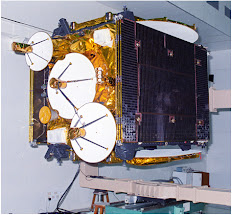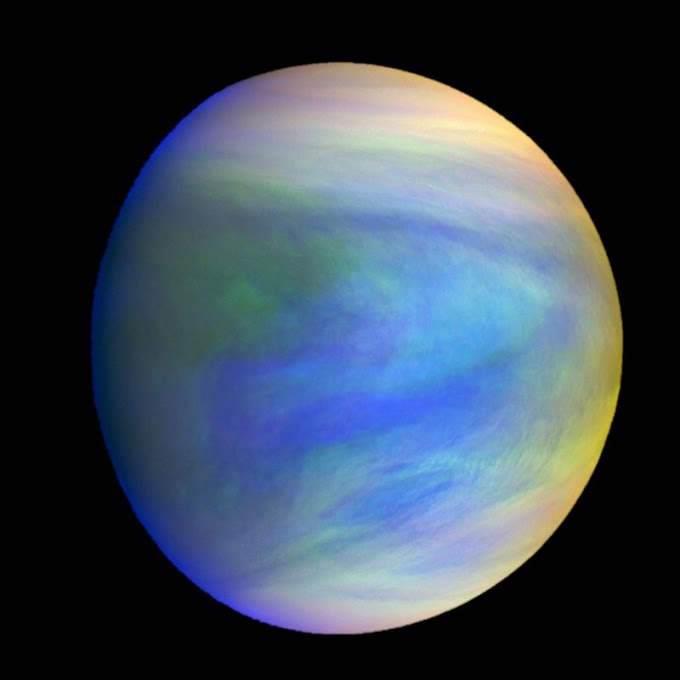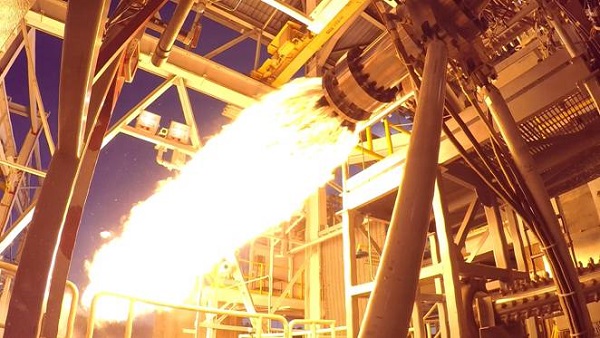INSAT
The Indian National Satellite System or INSAT is a series of multipurpose geostationary satellite launched by ISRO to satisfy the telecommunication, broadcasting, meteorology and search and rescue operations. Commissioned in 1983, INSAT is the largest domestic communication system in the Indo-Pacific Region. It is a joint venture of the Department of Space, Department of Telecommunication. The overall coordination and management of the INSAT system rest with the Secretary-level INSAT Coordination Committee.
INSAT satellites provide transponders in various bands (C, S, Extended C and Ku) to serve the television and communication needs of India Some of the satellites also have the Very High-Resolution Radiometer(VHRR), CCD Camera for meteorological imaging. The satellites also incorporate transponder(s) for receiving distress alert signals for search and rescue missions in the South Asian and Indian Ocean Region.

|
NAME
|
DATE
|
LAUNCH VEHICLE
|
|
INSAT – 1A
|
April 10, 1982
|
Delta
|
|
INSAT – 1B
|
Aug 30, 1983
|
Shuttle [PAM-D]
|
|
INSAT – 1C
|
July 22, 1988
|
Ariane-3
|
|
INSAT – 1D
|
June 12,1990
|
Delta 4925
|
|
INSAT – 2A
|
July 10, 1992
|
Ariane-44L H10
|
|
INSAT – 2B
|
July 23, 1993
|
Ariane-44L H10+
|
|
INSAT – 2C
|
Dec 07, 1995
|
Ariane-44L H10-3
|
|
INSAT – 2D
|
July 4,1997
|
Ariane-44L H10-3
|
|
INSAT – 2E
|
April 03, 1999
|
Ariane-42P H10-3
|
|
INSAT – 3B
|
March 22,2000
|
Ariane – 5G
|
|
INSAT – 3C
|
Jan 24,2002
|
Ariane5 – V147
|
|
INSAT – 3A
|
April 10,2003
|
Ariane5 – V160
|
|
INSAT – 3E
|
Sep 28, 2003
|
Ariane5 – V162
|
|
INSAT – 4A
|
Dec 22, 2005
|
Ariane5 – V169
|
|
INSAT – 4C
|
Jul 10,2006
|
GSLV – F20
|
|
INSAT – 4B
|
Mar 12, 2007
|
Ariane5
|
|
INSAT – 4CR
|
Sep 02, 2007
|
GSLV – F04
|
|
INSAT – 3D
|
July.26,2013
|
Ariane-5 VA-214
|
|
INSAT – 3DR
|
Sep 08, 2016
|
PSLV –C35
|
INSAT - 1A
INSAT-1A was an India Communication Satellite which formed part of the Indian National Satellite System Launched in 1982, it was operated in at a longitude of 74° east. INSAT-1A was based upon a custom satellite bus developed for the INSAT - 1 series. It had a mass at launch of 1,152 kilograms (2,540 lb) and was expected to operate for 7 years. The spacecraft carried 12 C and 3 S-Band transponders, powered by a single solar array. NASA was contracted to launch INSAT-1A using a Delta 3910 rocket with a PAM-D upper stage. The launch occurred at 06:47 UTC on 10 April 1982, from Launch Complex 17A at Cape Canaveral Air Force Station. The satellite was successfully inserted into GTO, from which it raised itself into Geostationary Orbit. It received the International Designer 1982-031A and Satellite Catalog Number.
INSAT - 1B
INSAT-1B was launched on 30 August 1983, it almost suffered the same fate as the INSAT-1A. It was not until mid-September that Ford and Indian controllers succeeded in deploying its solar array. By then it had been stationed at 74°E in place of INSAT-1A. The full operational capability was achieved in October 1983. It continued to operate into 1990 with all its 4375 two-way voice or equivalent circuits in use. Around 36,000 earth images were returned.
INSAT - 1C
The INSAT-1C satellite was launched on 22 July 1988 from Kourou for location at 93.5°E to bring the INSAT system up to full capacity. Half of the 12 C-band transponders and its two S-band transponders were lost when a power system failure knocked out one of the two buses, but the meteorological earth images and its data collection systems were both fully operational.
INSAT - 1D
The specification for the INSAT-1D is the same as the INSAT-1B but with expanded battery and propellant capacities, launched on 12 June 1990 to conclude the first generation INSAT series.
INSAT - 2A
INSAT - 2A is a Multipurpose Communication, meteorology and Satellite-based search and rescue. Its weight is about 1906 kg with propellant 916 kg dry weight. The communication is C, extended C and S-band. The payloads are 2 C-band (for FSS),6 ext. C-band (for FSS) 2 S-band (for BSS),1Data relay transponder (for met.data), 1 transponder for research and rescue, Very High-Resolution Radiometer (VHRR) for meteorological observation with 2 km resolution in the visible and 8 km resolution in the IR band.Credit - VSSC
INSAT - 2B
INSAT - 2B is a Multipurpose Communication, meteorology and Satellite-based search and rescue. Its weight is about 1906 kg with propellant 916 kg dry weight. The communication is C, extended C and S-band. The Propulsion system is integrated bipropellant system ( MMH and N2 04) With sixteen 22 N thrusters and 440 N LAM. The payloads are 12C-band (for FSS),6 ext. C-band (for FSS) 2S-band (for BSS),1Data relay transponder (for met.data), 1 transponder for research and rescue, Very High-Resolution Radiometer (VHRR) for meteorological observation with 2 km resolution in
the visible and 8 km resolution in the IR band.Credit - VSSC
INSAT - 2C
Power of four C-band transponders increased to improve communication facilities in remote areas like Northeast and Andaman & Nicobar Islands. Coverage of two other C-band transponders is enlarged to include parts of Southeast Asia, Central Asia and West Asia. The weight is about 2106 kg with propellants 946 kg dry weight. The Onboard power is 1320 Watts. The payloads are 16C-band / extended C-band transponders (for FSS), 2 high power C-band transponders (for BSS), 1S-band transponder (for BSS),1C/S-band mobile communication transponder, 3 Ku-band transponders.Credit - VSSC
INSAT - 2D
INSAT-2D, identical to INSAT-2C, was launched on June 4, 1997, but the satellite became in-operable since October 4, 1997, following a power bus anomaly and associated problems. Hence it was replaced by in-orbit satellite, ARABSAT-1C, designated as INSAT - 2D. The weight is about 2079 kg with propellants, 995 kg dry weight. The Onboard power is 1650 Watts. The payloads are 16C-band / extended C-band transponders (forFSS), 2 high power C-band transponders (for BSS), 1S-band transponder (for BSS),1C/S-band mobile communication transponder, 3 Ku-band transponders. It failed in orbit.Credit - VSSC
INSAT - 2E
INSAT - 2E, the last of the INSAT -2 series of satellites built by ISRO, is a multi-purpose satellite for telecommunication, television broadcasting and meteorological services. The very High-Resolution Radiometer operates in three spectral bands with 2 km resolution in the visible band and 8km resolution in thermal infrared and water vapour bands. The water vapour band has been introduced in the INSAT system for the first time. In addition, INSAT - 2E also carries a Charge Coupled Device Camera, again for the first time in the INSAT. This camera also operates in three spectral bands - visible, near-infrared and short wave infrared - providing a spatial resolution of 1 km.
INSAT - 3A
INSAT–3A, the third satellite in INSAT–3 series is a multipurpose satellite for providing telecommunications, television broadcasting, meteorological and search and rescue services. It carries twenty-four transponders – twelve operating in the normal C – band frequency, six in extended C-band and six in Ku–band. INSAT–3A also carries a Ku–band beacon. For Meteorological observation, INSAT–3A carries a three-channel Very High-Resolution Radiometer (VHRR). In addition, INSAT–3A carries a Charge Coupled Device (CCD) camera which operates in the visible and short wave infrared bands providing a spatial resolution of 1 km. A Data Relay Transponder (DRT) operating in UHF band is incorporated for real-time hydro-meteorological data collection from unattended located on land and river basins. The data is then relayed in extended C–band to a central location. INSAT–3A also carries another transponder for Satellite Aided Search and rescue (SA&R) as part of India’s contribution to the international Satellite Aided Search Programme.Credit - VSSC
INSAT - 3B
INSAT – 3B is the first of the five ISRO built satellites under INSAT – 3 series to join INSAT system. INSAT – 3B is collocated with INSAT – 2E at 83 deg East Longitude. This satellite primarily serves to business communication, mobile communication and developmental communication; It provides the first set to transponders for Swaran Jayanti Vidya Vikas Antariksh Upagraha Yojana (Vidya Vahini) for interactive training and developmental communication giving a fillip to the training and developmental Communication channel of INSAT. Their payloads are
- 12 extended C – band Transponders
- Five Ku band Transponders
- Mobile Satellite Services (MSS)
Credit - VSSC
INSAT - 3C
INSAT-3C, carrying Fixed Satellite Services (FSS) transponders, Broadcast Satellite Services (BSS) transponders and Mobile Satellite Services (MSS) transponders is intended to continue the service of INSAT-2DT and INSAT-2C which were nearing their end to life besides improving and augmenting the INSAT system capacity. INSAT-3C is the second satellite of the INSAT-3 series. The first satellite, INSAT-3B was launched in March 2000. Their payloads are
- 24 C band transponders
- 6 Extended C - band Transponders
- 2 S-band Transponders
Credit - VSSC
INSAT - 3D
NSAT-3D is an advanced weather satellite of India configured with improved Imaging System and Atmospheric Sounder. INSAT-3D is designed for enhanced meteorological observations, monitoring of land and ocean surfaces, generating a vertical profile of the atmosphere in terms of temperature and humidity for weather forecasting and disaster warning.
It carries four payloads -
- 6 channel multi-spectral Imager
- 19 channel Sounder
- Data Relay Transponder (DRT)
- Search and Rescue Transponder
The payloads of INSAT-3D provides continuity and further augment the capability to provide various meteorological as well as search and rescue services.Credit - VSSC
INSAT - 3DR
INSAT-3DR similar to INSAT-3D is an advanced meteorological satellite of India configured with an imaging System and an Atmospheric Sounder. The significant improvements incorporated in INSAT-3DR are:
- Imaging in Middle Infrared band to provide night time pictures of low clouds and fog
- Imaging in two Thermal Infrared bands for estimation of Sea Surface Temperature (SST) with better accuracy
- Higher Spatial Resolution in the Visible and Thermal Infrared bands
INSAT-3DR carries a multispectral imager, 19 channel Sounder, Data Relay Transponder and Search and Rescue Transponder.
INSAT - 3E
INSAT-3E is the fourth satellite launched in the INSAT-3 series. It is an exclusive communication satellite to further augment the communication services that are being provided by the INSAT system. Weighing 2775 kg at lift-off, INSAT-3E carries 24 Normal C-band and 12 Extended C-band transponders.Credit - VSSC
INSAT - 4A
INSAT-4A first in INSAT-4 Satellites series provides services in Ku and C-band frequency bands. The Ku transponders cover the Indian mainland and C-Band transponders cover an extended area. It has a dozen Ku transponders and another dozen of C-band transponders. This spacecraft is placed at 83o E along with INSAT-2E and INSAT-3B, by Ariane launch vehicle (ARIANE5-V169).Credit - VSSC
INSAT - 4B
INSAT–4B Spacecraft is the second in the INSAT 4 series of spacecraft and is configured with exclusive communication payloads to provide services in Ku and C frequency bands. This is co-located with INSAT–3A at 93.5 o E longitude. The payloads are 12 Ku band high power transponders covering Indian mainland using 140W radiatively cooled TWTAs. 12 C band high power transponders with extended coverage, covering southeast and northwest region apart from the Indian mainland using 63 W TWTAs.Credit - VSSC
INSAT - 4C
India's Geosynchronous Satellite Launch Vehicle (GSLV-F02), with INSAT-4C on board, was launched from Satish Dhawan Space Centre SHAR (SDSC SHAR), Sriharikota on July 10, 2006. However, GSLV-F02 could not complete the mission.
INSAT - 4CR
INSAT–4CR spacecraft is configured with exclusive Ku band employing the I-2K Bus with a mass of 2130 Kg. It was injected into the orbit by GSLV-F04 rocket with enhanced Russian Cryogenic engine and co-located at 74o East longitude along with INSAT–3C / Kalpana–1 / GSAT–3 (EDUSAT).
INSAT-4CR carries 12 high-power Ku-band transponders designed to provide Direct-to-home (DTH) television services, Video Picture Transmission (VPT) and Digital Satellite News Gathering (DSNG).Credit - VSSC























0 Comments